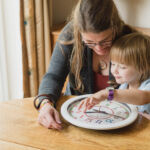
The easy way to learn how to tell the time on a clock
Is your child struggling to read an analogue clock? Perhaps you yourself have had trouble reading the time? For over 20 years, we have been working to make learning how to tell the time on a clock more accessible and enjoyable for children and adults. So, let’s take a look at our two intuitive methods for all learners and how these time-telling processes can transform the way your child understands time.
How to tell the time on a clock
Many children find it difficult to read the time on an analogue clock. This may be something that you have already noticed in your child, or it may be a concern that you are keen to address ahead of the new school year.
We identified these difficulties in children several years ago, and we worked with a group of children to identify the two key causes of their confusion and hesitancy. Both issues come from design flaws on the clocks themselves, as the first is regarding the limited information contained on the face of a clock.
First, regular clocks and watches typically display only hour numbers and some small markings to indicate minutes without actually displaying the 60 minutes within each hour. Whilst this is usually enough information for an experienced time-telling adult to gauge the time, it actually represents just 20% of the information needed to accurately read the time. The remaining 80% – including crucial context like minute details and clear hand positioning – is missing.
The second issue regards the hands of a clock. On most clocks the two hands are often nearly the same length which makes it confusing for people to determine which number to read first. They are also often positioned between numbers, rather than landing on a specific minute marker, which makes it even more challenging to accurately read the time. This lack of clarity makes learning to tell time challenging and frustrating for many children, and for those who struggle with dyscalculia or similar challenges, these struggles can continue long into adulthood.
EasyRead Time Teacher
This is where EasyRead comes in. Our clock face designs carry all the information that is needed to tell the time and each minute of the day is carefully enclosed in separate sections so that the tips clearly point to specific numbers
We also separate the hour and minute sections of the clock into two clear circles, and each hand is enclosed in its own circle to avoid any confusion. So, now that you are familiar with our design, it’s time to take a look at the two simple ways to read an EasyRead clock.
3 step process
Our first method follows the usual process of reading a clock – the ‘past & to’ method. This popular time-telling technique is the one taught in UK primary schools, so if you’re looking to support your little ones’ learning, this is a straightforward method that reinforces their new skills.
Step 1: First, look at the long hand and read the number at the end of it. This number represents the minutes.
Step 2: Next, state whether the minute hand is on the “past” side or the “to” side of the clock. This helps children understand whether the minutes are counting past the current hour or towards the next one.
Step 3: Finally, look at the short hand and read the number at the end to state the hour.
And there you have it! Simple, straightforward, and requiring no guesswork, our structured approach uses all the information available on the clock and makes telling the time an easy game of ‘say what you see’.
2 step process
Perhaps you tell the time another way – as if you’re reading a digital clock? We aim to make learning how to tell the time on a clock accessible for all, which is why we also offer 12/24 hour clocks which only require 2 steps to read.
Step 1: First, look at the hour hand and read the number that it is pointing to.
Step 2: Next, look at the minute hand and read the number at the end.
Say these numbers out loud as you read them to state the current time. For example, if the time is “1:52,” simply say “One, fifty-two.”
How to tell the time on a clock with EasyRead
Which of these methods will work the best for you? Refer back to them as needed and enjoy practising the right method for you with our full range.